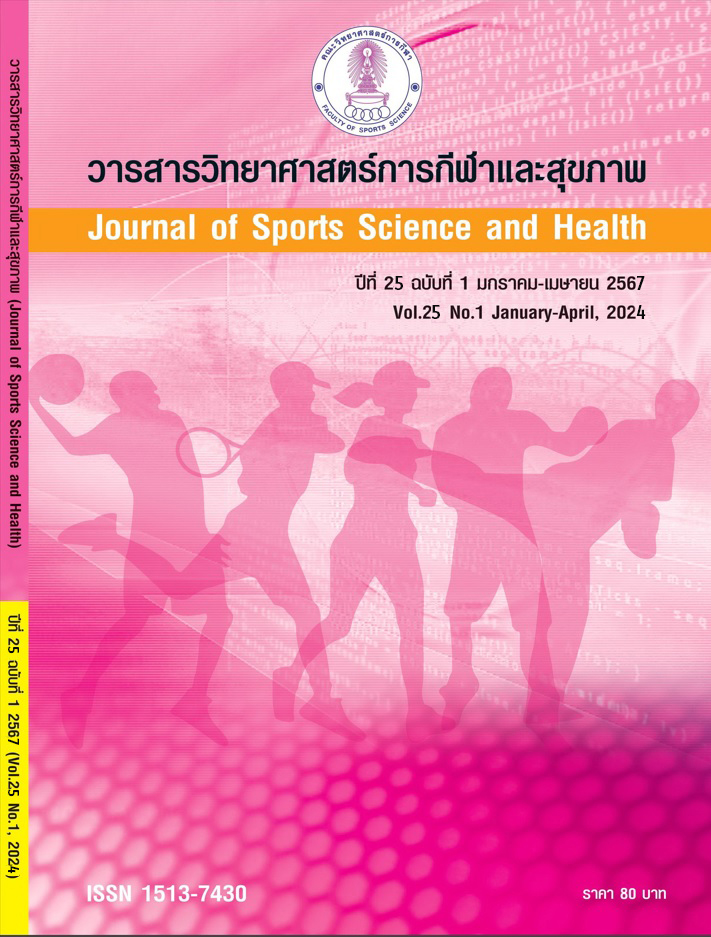การฝึกหายใจแบบฟาริเนลลี: แนวทางที่ไม่ใช้ยาที่มีศักยภาพในการเพิ่มสมรรถภาพปอดในผู้ป่วยโรคปอดอุดกั้นเรื้อรัง
Main Article Content
บทคัดย่อ
วัตถุประสงค์
การวิจัยในครั้งนี้มีวัตถุประสงค์เพื่อศึกษาผลของการฝึกหายใจแบบฟาริเนลลีที่มีต่อสมรรถภาพปอดในผู้ป่วยโรคปอดอุดกั้นเรื้อรัง
วิธีดำเนินการวิจัย
กลุ่มตัวอย่างเป็นผู้ป่วยโรคปอดอุดกั้นเรื้อรัง ที่เข้ารับการรักษา ณ โรงพยาบาลพระมงกุฎเกล้า อายุระหว่าง 51-80 ปี เพศชายและหญิงที่มีคุณสมบัติตามเกณฑ์ จำนวน 12 คน แบงกลุ่มตัวอย่างเป็น 2 กลุ่ม ได้แก่ กลุ่มที่ 1 ได้รับการฝึกหายใจแบบฟาริเนลลี จำนวน 6 คน และกลุ่มที่ 2 ได้รับการฝึกหายใจแบบใช้กะบังลม จำนวน 6 คน โดยแต่ละกลุ่มจะได้รับการฝึกหายใจ 5 ครั้งต่อสัปดาห์ เป็นเวลา 8 สัปดาห์ ก่อนและหลังการทดลองทำการทดสอบตัวแปรด้านสรีรวิทยาและตัวแปรด้านสมรรถภาพปอด จากนั้นนำมาวิเคราะห์ผลทางสถิติโดยเปรียบเทียบความแตกต่างระหว่างก่อนและหลังการทดลองด้วยการทดสอบค่าทีแบบรายคู่ (Paired t-test) และวิเคราะห์เปรียบเทียบความแตกต่างระหว่างกลุ่มด้วยการทดสอบค่าทีแบบอิสระ (Independent t-test) ที่ระดับความมีนัยสำคัญทางสถิติที่ .05
ผลการวิจัย
หลังการทดลอง 8 สัปดาห์ ไม่พบความแตกต่างของค่าเฉลี่ยข้อมูลด้านสรีรวิทยา ได้แก่ น้ำหนักตัว อัตราการเต้นหัวใจขณะพัก ความดันโลหิตขณะหัวใจบีบตัว ความดันโลหิตขณะหัวใจคลายตัว ดัชนีมวลกาย ค่าร้อยละไขมันในร่างกาย และค่าร้อยละของระดับออกซิเจนในเลือดแดงเมื่อเปรียบเทียบทั้งระหว่างก่อนและหลังการทดลองและระหว่างกลุ่ม สำหรับตัวแปรด้านสมรรถภาพปอดพบว่ากลุ่มที่ได้รับการฝึกหายใจแบบฟาริเนลลี มีค่าปริมาตรของอากาศที่ถูกขับออกในวินาทีแรกของการหายใจออกอย่างเร็วและแรงเต็มที่ ค่าปริมาตรของอากาศจากการหายใจเข้า-ออกเต็มที่ในเวลา 1 นาที ค่าปริมาตรสูงสุดของอากาศที่หายใจออก และค่าความจุหายใจเข้า เพิ่มขึ้นแตกต่างกับก่อนการทดลองอย่างมีนัยสำคัญทางสถิติที่ระดับ .05 ในส่วนของกลุ่มที่ได้รับการฝึกหายใจแบบใช้กะบังลม มีค่าความจุหายใจเข้าเพิ่มขึ้นแตกต่างกับก่อนการทดลองอย่างมีนัยสำคัญทางสถิติที่ระดับ .05 และเมื่อเปรียบเทียบระหว่างกลุ่มพบว่าทั้งสองกลุ่มมีค่าเฉลี่ยตัวแปรด้านสมรรถภาพปอดไม่แตกต่างกัน
สรุปผลการวิจัย
การฝึกหายใจแบบฟาริเนลลีเป็นระยะเวลา 8 สัปดาห์ สามารถช่วยเพิ่มสมรรถภาพปอดได้ใกล้เคียงกับการฝึกหายใจแบบใช้กะบังลมในผู้ป่วยโรคปอดอุดกั้นเรื้อรังได้
Article Details

อนุญาตภายใต้เงื่อนไข Creative Commons Attribution-NonCommercial-NoDerivatives 4.0 International License.
เอกสารอ้างอิง
Anzueto, A., & Miravitlles, M. (2017). Pathophysiology of dyspnea in COPD. Postgraduate Medical, 129(3), 366-374.
Bunlam, K., Rojnawee, S., Pojsupap, S., Suksawat, Y., & Tongtako, W. (2 0 2 1). Effects of Sustained Maximum Inspiration Versus Balloon-Blowing Breathing Exercise on Pulmonary Function in School-age Children with Asthma. Journal of Sports Science and Health. 22(1), 103-119.
Cancelliero-gaiad, K. M., Ike, D., Pantoni, C. B., Borghi-silva, A., & Costa, D. (2014). Respiratory pattern of Diaphragmatic breathing and Pilates breathing in COPD subjects. Brazilian Journal of Physical Therapy, 18(4), 291-299.
Cooper C.B. (2009). Desensitization to dyspnea in COPD with specificity for exercise training mode. International journal of chronic obstructive pulmonary disease, 4, 33-43.
Dechman, G., & Wilson, C.R. (2004). Evidence Underlying Breathing Retraining in People with Stable Chronic Obstructive Pulmonary Disease. Physical Therapy, 84(12), 1189-1197.
Dujic, Z., & Breskovic, T. (2012). Impact of breath holding on cardiovascular respiratory and cerebrovascular health. Sports medicine (Auckland, N.Z.), 42(6), 459-472.
Fernandes, M., Cukier, A., & Feltrim, M.I. (2011). Efficacy of diaphragmatic breathing in patients with Chronic Obstructive Pulmonary Disease. Chronic Respiratory Disease, 8(4), 237-244.
Fregonezi, G.A., Resqueti, V.R., & Güell Rous, R. (2004). Pursed lips breathing. Archivos de bronconeumologia, 40(6), 279–282.
Global Initiative for Chronic Obstructive Lung Disease. (2020). Global Strategy for the Diagnosis, Management and Prevention of COPD (2018 report). Retrieved March 1, 2020, from GOLD COPD: Available from https://goldcopd.org/wp-content/uploads/2019/11/GOLD-2020-v6.0-FINAL-revised-20-Nov_WMS.pdf.
Gosselink, R. (2004). Breathing techniques in patients with chronic obstructive pulmonary disease (COPD). Chronic Respiratory Disease, 1(3), 163-72.
Hill, C.J., Lazzeri, M., & D’Abrosca, F. (2018). Breathing Exercises and Mucus Clearance Techniques in Pulmonary Rehabilitation. In Clini, E., Holland A, E., Pitta, F., & Troosters, T. Textbook of Pulmonary Rehabilitation. (205-216). Charm: Springer International.
Holland, A.E., Hill, C.J., Jones, A.Y., & McDonald, C.F. (2012). Breathing exercises for chronic obstructive pulmonary disease. Cochrane Database of Systematic Reviews, 10, CD008250.
Imam, M.I., James, J.N., & Akor-Dewu, M.B. (2017). A cross sectional study on lung functions in athletes, singers, and individuals with sedentary lifestyles in Ahmadu Bello University, Zaria. Bayero Journal of Pure and Applied Science, 10(2), 83-87.
Kant, S., & Singh, G.V. (2006). Breathing exercise as adjuvant in the management of COPD. Lung India, 23(4), 165-169.
Marciniuk, D.D., Brooks, D., Butcher, S., Debigare, R., Dechman, G., Ford, G., Pepin, V., Reid, D., Sheel, A.W., Stickland, M.K., Todd, D.C., Walker, S.L., Aaron, S.D., Balter, M., Bourbeau, J., Hernandez, P., Maltais, F., O'Donnell, D.E., Bleakney, D., Carlin, B., Goldstein, R., Muthuri, S.K., & Canadian Thoracic Society COPD Committee Expert Working Group. (2010). Optimizing pulmonary rehabilitation in chronic obstructive pulmonary disease--practical: a Canadian Thoracic Society Clinical Practice Guideline. Canadian Respiratory Journal, 17(4), 159-168.
Miller, R. (1987). The Structure of Singing: System and Art in Vocal Technique. New York: Schirmer Book.
Nield, M.A., Soo, H.G.W., Roper, J.M., & Santiago, S. (2007). Efficacy of pursed-lips breathing: a breathing pattern retraining strategy for dyspnea reduction. Journal of Cardiopulmonary Rehabilitation and Prevention, 27(4), 237-244.
O'Donnell, D.E., Milne, K.M., James, M.D., de Torres, J. P., & Neder, J. A. (2020). Dyspnea in COPD: New Mechanistic Insights and Management Implications. Advances in therapy,37(1), 41-60.
Opaspasu, A., Trisarawat, P., Kongamnoisak, U., & Buranapuntalung, S. (2016). The immediate effects of costal breathing exercise with sustained maximal inspiration technique and flow incentive spirometer on chest expansion in sedentary young adults. Thammasat Medical Journal. 16(2), 220-229.
Orozco-Levi, M. (2003). Structure and function of the respiratory muscles in patients with COPD: impairment or adaptation? European Respiratory Journal, 22(Supplement 46), 41s-51s.
Phillips, K.H. (2013). Teaching Kids to sing. Boston: Schirmer.
Roy, A.S., & Bandyopadhyay, A. (2015). Pulmonary function in female singers of Kolkata, India. Journal of Human Ergology, 44(2), 75-81.
Visser, F.J., Ramlal, S., Dekhuijzen, P.N., & Heijdra, Y.F. (2011). Pursed-lips breathing improves inspiratory capacity in chronic obstructive pulmonary disease. Respiration, 81(5), 372-378.
Yamaguti, W.P., Claudino, R.C., Neto, A.P., Chammas, M.C., Gomes, A.C., Salge, J.M., Moriya, H.T., Cukier, A., & Carvalho, C. (2012). Diaphragmatic breathing training program improves abdominal motion during natural breathing in patients with chronic obstructive pulmonary disease: a randomized controlled trial. Archives of Physical Medicine and Rehabilitation, 93(4), 571-577.
Zhang, Z. Q., Chen, R.C., Yang, Q.K., Li, P., Wang, C.Z., & Zhang, Z.H. (2008) A randomized controlled trial study of pulmonary rehabilitation with respiratory physiology as the guide on prognosis in patients with chronic obstructive pulmonary disease. Chinese Critical Care Medicine, 20(10), 607-610.


